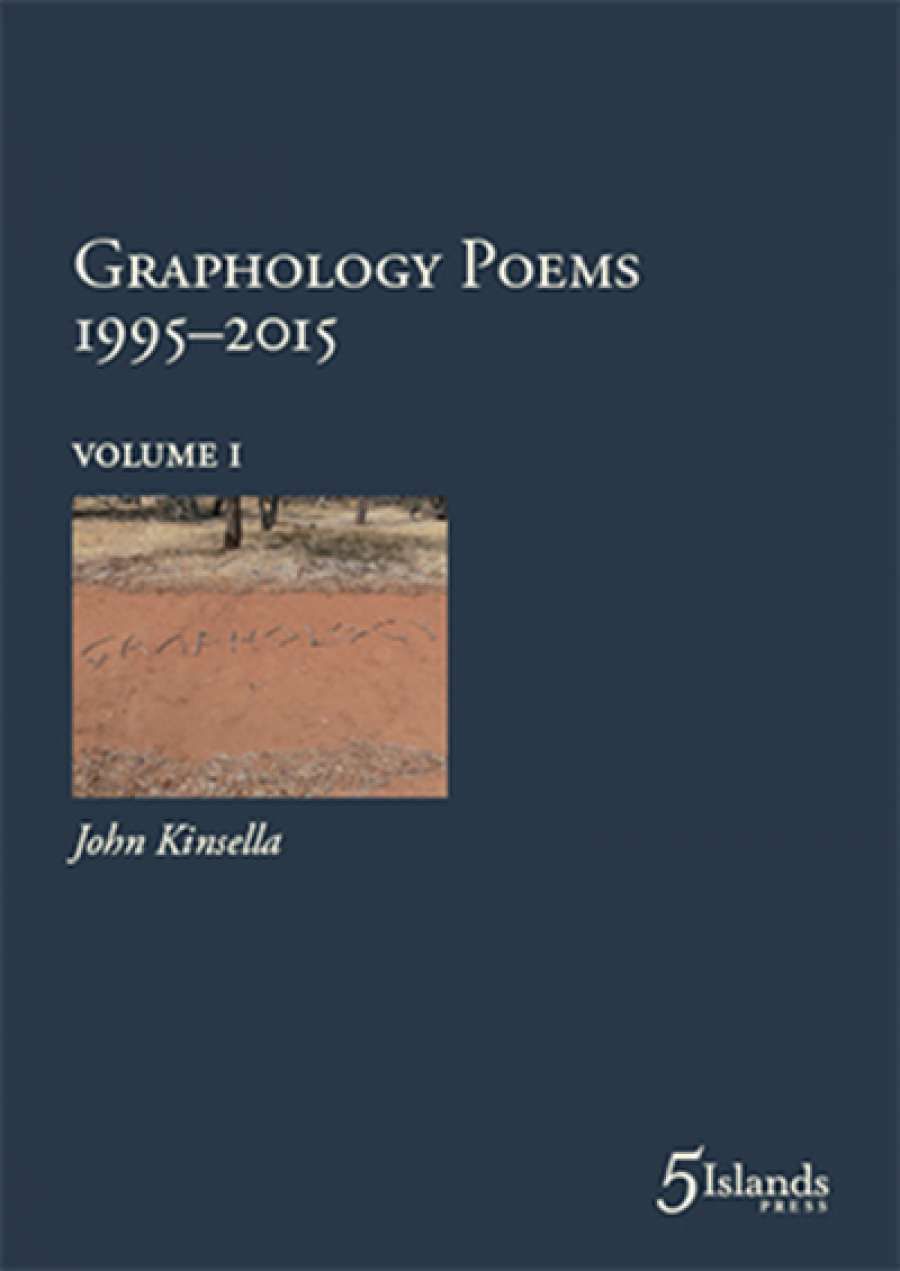
- Free Article: No
- Contents Category: Poetry
- Custom Article Title: David McCooey reviews 'Graphology Poems 1995–2015, Vols I-III' by John Kinsella
- Review Article: Yes
- Online Only: No
- Book 1 Title: Graphology Poems 1995–2015, vols I-III
- Book 1 Biblio: Volume I, 268 pp, 9780734051639 Volume II, 281 pp, 9780734051646 Volume III, 246 pp, 9780734051653
Facsimiles of handwriting, doodles, and even scribble can be found in Graphology Poems, but more notable, more ‘telling’, are the poetic images of the vast material history of writing found here. The book is replete with typewriters, computers, dictionaries, IOUs, visitors’ books, prize books, errata, bibliographies, notaries, documents in triplicate, surveys and reports, printer’s sheets, and – of course – lines of poetry. These lines of poetry are by a writer utterly taken up with the materiality of language, and by the intense, sometimes mysterious processes, in which the material world becomes the stuff of language. We see this dynamic relationship between words and the world in Kinsella’s attraction to nouns, especially proper nouns. His poetry teems with things: objects, animals, places, and people. The attraction to things can be seen in Kinsella’s use of catalogue, that most ancient of poetic forms. ‘Graphology 9’, for instance, uses catalogue to sketch out a family history:
a ballerina, an opera singer,
a poorly paid landscape artist,
a military man who was lost in India,
a number of petty bureaucrats,
a cigar manufacturer,
a preacher from a dissenting church,
a swag of colonists and teachers,
a suicide, a seamstress,
and a piano teacher.
Graphology Poems exhibits a tension in Kinsella’s work between mobility (the moving between places and times) and stasis (the intense scrutiny of those times and places). Characteristic, too, is Kinsella’s sensitivity to the ways in which places are the site of human destructiveness. Many of the poems here – as elsewhere in Kinsella’s work – are powerful denunciations of modernity. But Graphology Poems also includes several poems that are wholly singular in Kinsella’s vast oeuvre. One of these, ‘Graphology 3834’, I quote in full: ‘I’ve decided to become fantastical. / I’ve decided to give up on the facts, / the points of repair, the markers / on horizons. All swirls, digresses. / I will call back the dragons. / The facts will be reinstated; / then, and only then.’
It goes without saying that bringing together twenty years of poems on place and identity is a vast undertaking, and one heroically realised by Five Islands Press. But what is perhaps most extraordinary about this work is the equal relationship between the whole and its parts. As the American scholar Nicholas Birns writes in his long essay on Graphology Poems (available on the Five Islands Press website), ‘What astonishes about Kinsella is that this vast, dilating rhizome, this meme of global poeticizing, coexists with an intense dedication to craftsmanship on the level of the individual poem.’
 John KinsellaThis is an important observation, especially for those tempted to give Kinsella’s politics more attention than his poetics. Of course, one cannot separate the two, but it can be worthwhile doing so briefly if only for heuristic reasons (to evoke a late section of the Graphology Poems). The volume and intensity of Kinsella’s poetry, its sense of immediacy and speed, should not stop us from giving these poems the careful readings they deserve. The inventiveness and playfulness of Kinsella’s poems, on full display here, are central to his poetics. (In this respect he reminds me of Les Murray, however different the two poets might be politically.) There are puns and wordplay of all kinds here; extended metaphors; rhyme, half-rhyme, and assonance; rhetorical figures such as anaphora, personification, and chiasmus; refrains; the strategic confusion of poetic and non-poetic registers; jokes; an attention to prosody (often, as Birns points out, through syllabic patterning); and an encyclopedic inter-textuality.
John KinsellaThis is an important observation, especially for those tempted to give Kinsella’s politics more attention than his poetics. Of course, one cannot separate the two, but it can be worthwhile doing so briefly if only for heuristic reasons (to evoke a late section of the Graphology Poems). The volume and intensity of Kinsella’s poetry, its sense of immediacy and speed, should not stop us from giving these poems the careful readings they deserve. The inventiveness and playfulness of Kinsella’s poems, on full display here, are central to his poetics. (In this respect he reminds me of Les Murray, however different the two poets might be politically.) There are puns and wordplay of all kinds here; extended metaphors; rhyme, half-rhyme, and assonance; rhetorical figures such as anaphora, personification, and chiasmus; refrains; the strategic confusion of poetic and non-poetic registers; jokes; an attention to prosody (often, as Birns points out, through syllabic patterning); and an encyclopedic inter-textuality.
Regarding this last point, Graphology Poems is capacious in its postmodern referentiality. The poems take in Andy Warhol, racist graffiti in a Kelmscott bus stop, Middle English, Middlemarch, the Dead Sea Scrolls, Thomas Lovell Beddoes, an AC/DC cover band, and so on. But this isn’t ‘merely’ – should one want to use that modifier – postmodern plenitude, or specificity, or irony, or whatever. The specific details of the Graphology Poems unite subjective and material places, in particular Western Australia, Ohio, and Cambridge. Such places stage the collision between the human and the non-human. This collision is sometimes benign and creative, but it is often destructive, a source of elegy, polemic, or satire.
But Kinsella’s poetry, however harsh it can be, retains a sense of optimism, as Graphology Poems illustrates. At its most fundamental level, Graphology Poems is not only a poetry of critique, but also one of positivity, producing a shared virtual space for Kinsella and his readers to engage in that beautiful pseudoscience called poetry.
Graphology Poems is a major publishing event in Australian poetry. In what is surely Kinsella’s magnum opus, we find the dragons and the facts miraculously together on common ground.


Comments powered by CComment